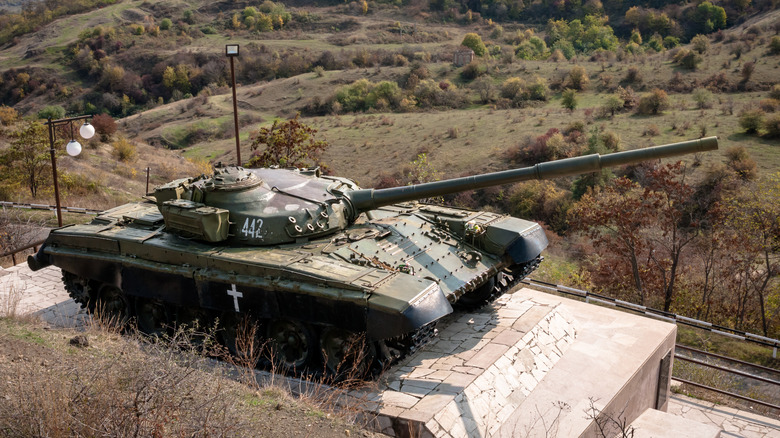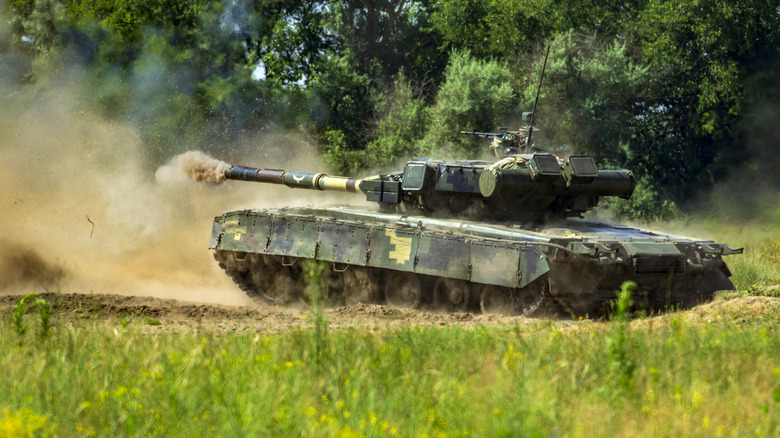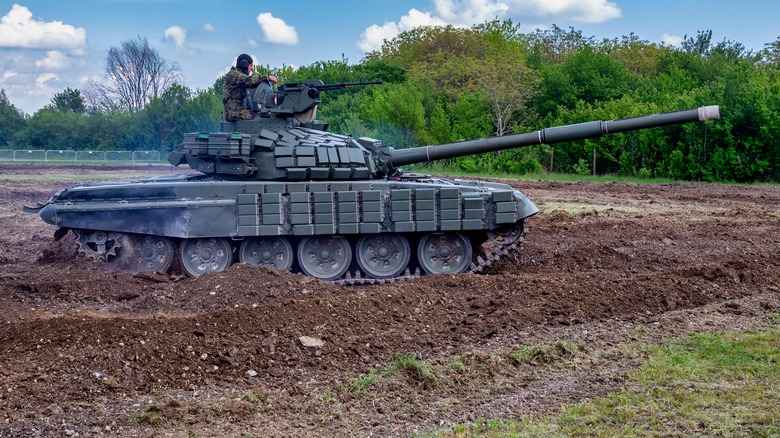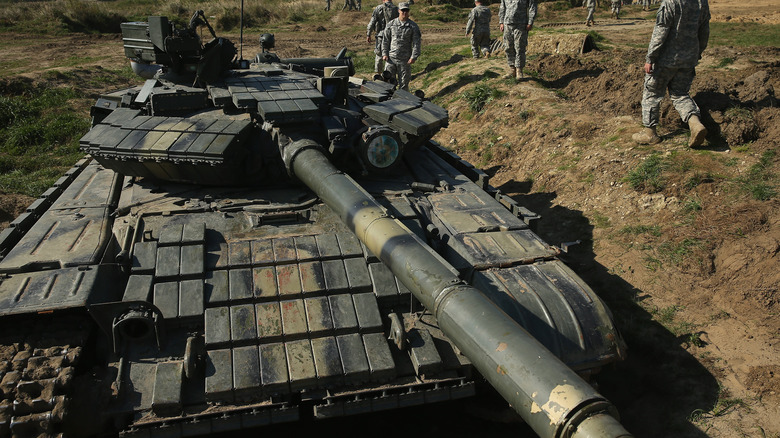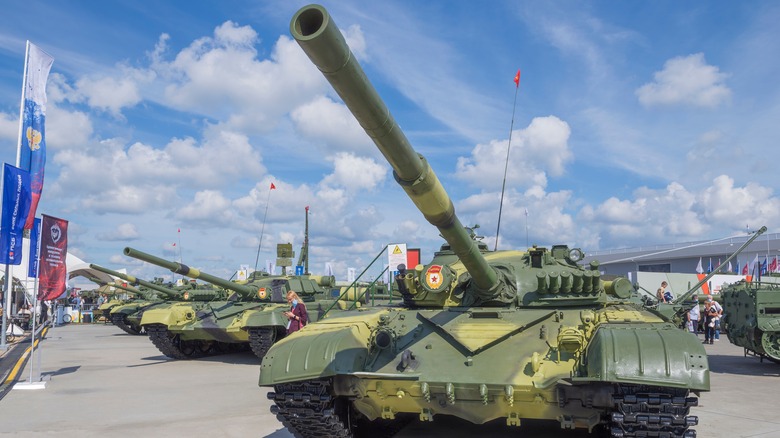The Soviet Union's T-72 Vs T-80: The Big Differences Between Two Battle Tanks
Regardless of what the world of video game slang may have you believe, tanks aren't all intended to simply turtle up and absorb heavy damage. Lighter, more maneuverable models exploit their mobility to support allied units. Heavier models, meanwhile, evolved into the first main battle tanks, such as Britain's 55-ton Chieftain from the Cold War.
The Soviet Union, needless to say, hastened to unleash its take on the main battle tank, a versatile class of weapon that was intended to boast the power, mobility, and protection of both medium and heavy tanks. Their efforts in this area resulted in, among others, the T-72 and T-80 models. The two tanks, as their designations imply, are similar models, but some key differences set them apart.
You may think that the T-80 — dubbed the T-72 1981/3 by the Soviets — would be a rather straightforward upgrade of the earlier T-72, but there's much more to the equation than that. Here are some of the most notable differences between the two Soviet heavyweights (though perhaps not as heavy as the ill-fated Object 279).
Armor
Main battle tanks, of course, are primarily designed to engage and destroy their counterparts on the opposing side. Armor is paramount, then. When it comes to the former, the original T-72, first used in 1973, had considerably less sophisticated protection. It was created as a more trustworthy replacement for the T-64 but did not have the composite armor that the model boasted.
Perhaps as a cost-cutting measure, the first T-72 model's armor favored thickness over specific materials. In Armor magazine in 1999, James M. Warford noted that this model had "all-steel turrets," as did the T-72M. Worthier defenses were needed to stand up against the anti-tank options the T-72 would face (as demonstrated in Lebanon in 1982), and the tank NATO would designate to be the T-80 was the product of considerable reinforcement.
In "Main Battle Tanks," V. I. Murankhovski states (via Warford) that the family of tanks was upgraded with a very special composite armor, which consisted of "an outer layer of steel, a center layer of sand or kvartz (quartz), and an inner layer of steel." So-called Combination K armor utilized "a center layer of combined steklotekstolit (a glass fiber material) and a package of ceramic plates" and was employed in the T-64A.
The addition of reactive armor (contained explosives that interfere with projectiles striking the hull) to the tank family meant that, overall, the T-80 was rather better protected than the original T-72, though the first model of the former wasn't compatible with reactive armor.
Engine comparison
Vehicles as hefty as main battle tanks, of course, need something very potent under the hood to perform consistently. On top of that, the engine and fuel type chosen and its positioning within the vehicle can have a big impact on its vulnerability in case of a direct hit.
In terms of engines, the original T-72 was equipped with a V46. This diesel engine boasted 780 horsepower, allowing the tank a top speed of around 37 mph. By contrast, the T-80 features a kerosene GTD-1000T, the very first model the Soviets developed to be powered by such. It made maintenance potentially more complicated and costly, but this was balanced by much-improved performance and an output of 1,000 horsepower. Armed with it, the model could reach speeds greater than 43 mph.
Some later models of the T-80 would utilize less complex engines, attempting to cut down the disadvantages of the GTD-1000T. These came with compromises in performance, though: the 1987 T-80UD's 6TD engine offered the same top speed capacity as the T-72. In September 2023, Forbes stated that Kaluga appears to be working on a 1,500-horsepower turbine engine. A new fleet of T-80s, then, could be capable of greater performance than ever.
Weaponry comparison
The final crucial component of a main battle tank is its arsenal. Here, both the T-72 and the T-80 offer considerable power. The T-72, in its initial configuration, boasted machine guns up to 12.7 mm and a formidable 125 mm main cannon. Later models would have their weaponry enhanced further, with the targeting systems improved alongside access to a range of ammunition, including 3VBK27 HEAT and explosive rounds.
The T-80, too, boasted a 125 mm gun supported by a machine gun calibrated to combat enemy aircraft. In tandem with its range of ammunition, this allowed the T-80 to combat a range of threats even more effectively, and it would also be improved with iterations that followed. The T-80B is one great example, capable of equipping and delivering Kobra missiles. T-80 specs continue to be iterated on, too: 2017's T-80BVM includes a PNM Sosna-U sight. Like the T-72, it's a formidable weapon that has appeared in many guises.
Not so different after all?
The complex nature of tank designations (the T-72 has been developed as the T-72A, T-72S, T-72M1M, and PT-91M, alongside so many others) can mean that it's difficult to determine what's truly different about a family of vehicles. The base T-80, for instance, didn't boast reactive armor, though later models would. The base T-72 didn't either, but the T-72S variant did.
Part of the complexity in the cases of the T-72 and T-80 derives from the fact that the former was exported to other nations and, so, could be taken on a different upgrade path there. The M-84AB1, for example, was enhanced in Yugoslavia and became an equivalent of the T-72B.
The original T-80, however, stands as an augmented version of the standard T-72, arriving later and boasting equipment that enhanced its performance in the areas most crucial for a main battle tank's operation. The T-72, despite its age, has benefited from a long string of improvements since its creation by the Soviet Union, and its widespread use is a testament to its effectiveness since then: the T-72A alone was fielded by 40 nations around the world.
Whether the T-80 itself can be simply deemed one of those upgrades is up for debate, but it's been (and remains) a powerful weapon indeed. The advent of the likes of China's T-99 may have taken something of the spotlight, but both models have an important place in the history of tank development.
